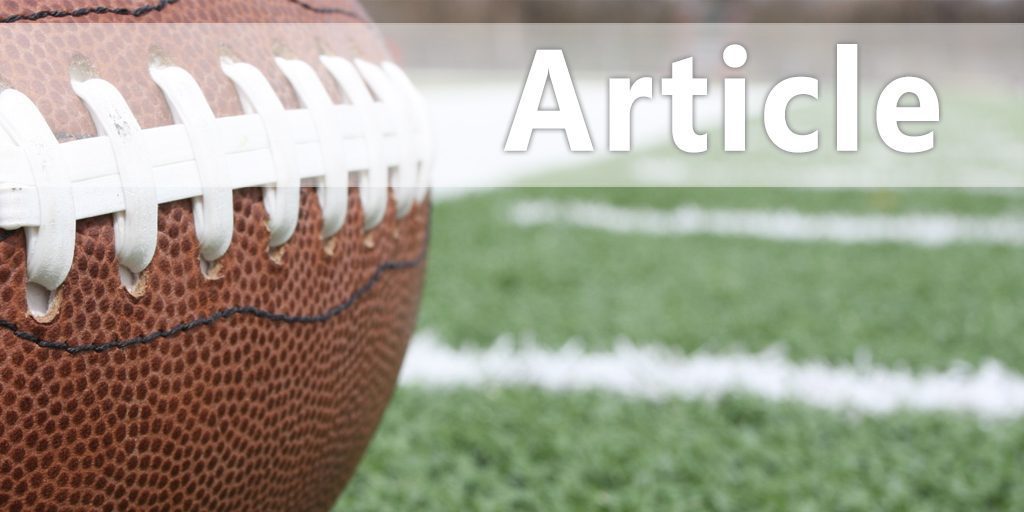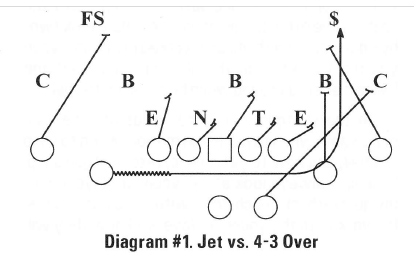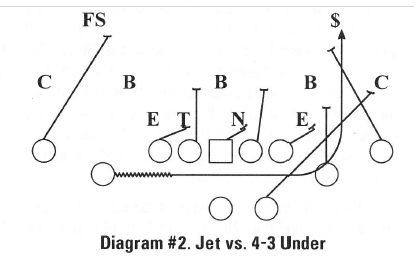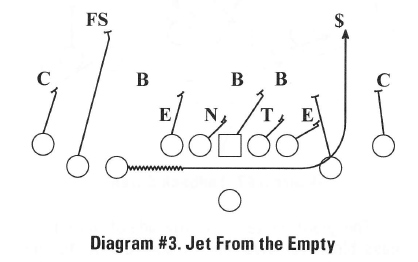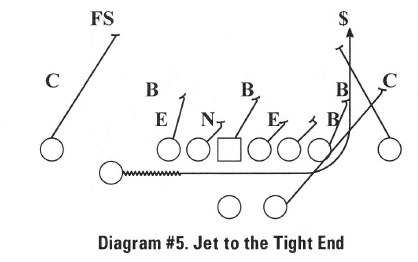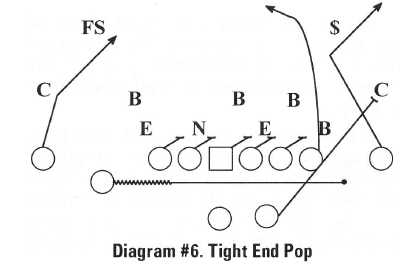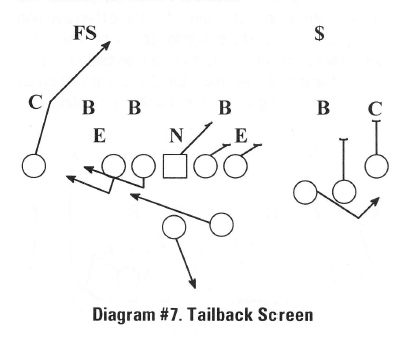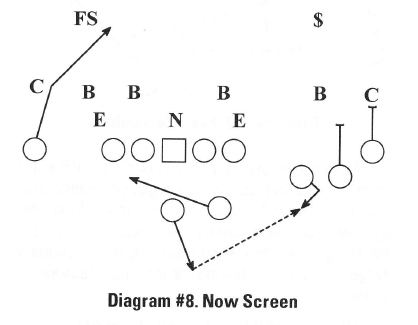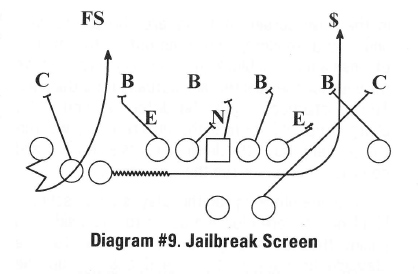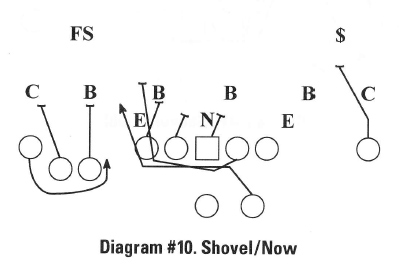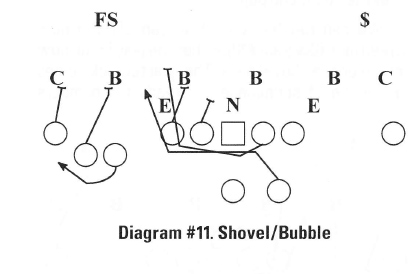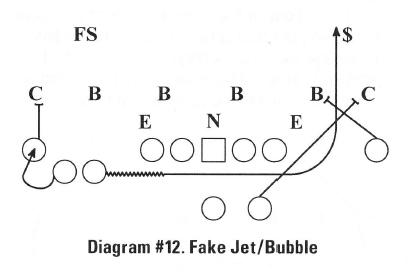|
by Doug Pearson- St. John's Jesuit High School & Academy, Ohio Excerpt from 2012 Nike Coach of the Year Clinics Notes by Earl Browning - www.coacheschoice.com Thank you for having me up here to speak. I have had many connections with Michigan coaches over the years. Living in Toledo, I am about a mile from the Michigan border. I worked at Michigan football camps many years ago. I worked for Jim Herman and many great Michigan coaches, and it was a lot of fun. I am going to talk to you about attacking the perimeter. The play that plays a big part in that is the jet sweep. It has been a good play for us. We ran the play years ago, but we were not very good at it. We changed the blocking scheme slightly and got some better athletes. That paid off for us very well. This year, we averaged 8.4 yards per carry with it. Two years ago, we averaged almost 11 yards per carry. The reason for that was the player carrying the ball ran the 100 meters in 10.7 seconds. Having players like that makes us all better coaches and gets us invited to speak at clinics. St. John's Jesuit is Catholic all-boys high school. We have 808 boys in grades 9 through 12. Our school is a member of the Three Rivers Athletic Conference. It is the only conference in Ohio with public and private schools. Three schools in the conference have won a state championship. We are not a huge school. We have a junior high that has about 150 boys enrolled. I have been at St. John's for 10 years. It is my alma mater, and we made the playoffs six of the 10 years. My overall record at St. John's is 79-32. We have some good players, and they are smart. We are building a new football stadium. Next year will be our first home football game. We played all our games on the road up to this point. We played our home schedule at other high school fields or at the University of Toledo stadium. We have some good players. Since I have been there, we have had 20 Division 1 or 1AA players. We currently have four linemen in Big Ten. We had three MAC players this year and seven overall. We now have three juniors with current Division 1 offers. We have not been shy on talent, particularly on the offensive and defensive lines. We averaged 270 pounds across the front this year. We are consistently in the top 10 in the state with team GPA. At St. John's, you must keep your grades up, or you cannot attend school there. In Ohio, we get 10 days of practice in the summer. This is how we organize that time:
We start with the jet play in the summer. It is very simple. The timing of the jet play is the entire thing. We run it out of 2x2, 3x1, empty, and toward a tight end. When we teach the timing, we work in three groups and use line spacers to represent the splits of the offensive linemen. We simply took two-by-fours, painted them, and worked off them. When you run the jet from the shotgun, you want the ballcarrier at full speed when he receives the ball. In the shotgun, it requires a lot of time. You must know when to put him in motion, when to snap the ball, and how to get an accurate shotgun snap. In camp, I always look at the younger players. I let my quarterback coach work with the older players, if I work with the younger players, I know they will work better because I am the head coach. We get as many players working as possible. The zone, jet sweep, and option are very similar schemes for us. They are the first three plays we put in every year in the run game. The next things are the power and quick series. When we get to two-a-day practice, we continue in our pre-practice with the focus on teaching rather than speed. We do not platoon. We do not have the numbers to do that. The big problem is the amount of linemen we have. We work offense in one session and defense in the other. We make the jet, plays off jet action, and play-action passes about one third of the script in camp. To be successful at the jet, you must practice it at full speed to ensure timing. Wide receivers drive me nuts. Obviously, I was never a wide receiver. They must block for this play to work. They are the key to the success of the play. They get excellent angle on this play, and for the most part they do a good job of blocking. This year, we saw the odd front in seven or eight games. We play a 4-3 defense, and I will start talking about that front. This first diagram is a 2x2 formation from the shotgun. The 4-3 defense in the diagram is an over front (Diagram #1). When we run the jet against the 4-3, we do not block the backside defensive end. The backside tackle goes under the defender and up to the backside linebacker. The backside guard probably will cut the 1 technique defender to his inside. That technique will vary with the type of players or game planning. The left wants to take a great angle off the ball and try to get a paw on the Mike linebacker. We do not expect a de-cleater, but we want to get a piece of him.
The left wants to make contact and try to stay on the linebacker and push him in that direction. You never know when the jet will turn back inside. The playside guard reaches the 3 technique tackle. If he is a big defender and we cannot handle him, we cut him. We cannot have penetration at this point. Our tackles have to be athletic. You cannot have a big, fat player in that position who cannot move his feet. That is fine if you drive block only, but we do more than that. The tackle does what we call a "basketball block." He has to step hard outside and reach the 5 technique defender. It is almost like boxing out for a rebound in basketball. It is a shield type of block. We want to occupy him and get outside of him. The outside receiver and slotback crack block on the Sam linebacker and strong safety. The slot receiver blocks the Sam linebacker, and the outside receiver comes down on the strong safety. The tailback leads around on the corner. We try to create an alley between the crack blocks and the block of the tailback. At times, the defenders fight outside too much, and the jet back has to turn up underneath the blocks. The aiming point for the jet back is the outside hip of the playside tackle. We were lucky last year. Our tackle, who is now playing for Michigan, could overtake most anyone we played against last year. If the 4-3 is an under front, we have some adjustments in the offensive line (Diagram #2). The backside guard and tackle switch assignments. The guard comes under the 3 technique defender and gets up on the linebacker. The backside tackle cuts the 3 technique defender. The left reaches or cuts the shade noseguard. The playside guard blocks the Mike linebacker, and the playside tackle reaches for the 5 technique defender. The perimeter blocking stays the same.
When we go to trips set, things change slightly. We have only one crack blocker to the playside. The single receiver has to block a linebacker on this play. It can be a physical mismatch; however, the block is all about angles. The crackback blocker has a great angle and can make the block. Last year, we had a 170-pound wide receiver who simply killed the linebackers. The jet back on this play is the inside slot player. The problem is the jet back must beat the safety 1-on-1. The tailback kicks out the corner, and the jet back has to make the safety miss. I like to run the play from a 2x2 or empty set rather than the 3x1 set. However, it gives us a change-up and fits into our play-action scheme. We align in the 3x1 set, fake the jet going to the single receiver side, and throw the two-man bubble screen to the trips side. In my opinion, the empty set is the best way to run this play (Diagram #3). The defense is a 4-3 defense, but realistically it is a 4-1 defense. The outside linebackers are half in the box and half out of the box. We run the jet toward the two-receiver side as we did from the trips set. The difference in this set is we have no tailback to lead on the corner. The line blocking is the same for the offensive line. They reach or cut the defender to the playside. The slot cracks on the linebacker; the outside receiver stalks the corner and base blocks him. If he can pin the corner, that gives the jet back the sideline.
If we run the play against 3-4 fronts, nothing changes (Diagram #4). The backside tackle is avoiding the 5 technique and getting inside to cut off the outside linebacker. The backside guard and left block the nose and backside linebacker using a combination block. The playside reaches, and the perimeter crack blocks on the safety and linebacker. The tailback leads on the corner. The coaching point for the playside guard is to take a great angle. He wants to angle to where the linebacker is going instead of where he aligns.
We assign the wide receiver to the backside to the free safety. Most people think that is a wasted block, but it has paid off on more than one occasion. I have seen this play cut back all the way to the backside free safety. Our goal is to have the safeties talking to themselves at halftime. If you motion as we do on the jet play, the safeties are too high to make a difference right away. To counter the motion, the defense buzzes the safeties down with the motion. When we get them to do that, we want to fake the jet and throw over the top. The outside receiver fakes, shows the crack on the safety, and turns up the field. We have all kinds of things we can run from this scheme. The way people play us is with a 3-4 front and soft cover 4 in the secondary. The defense will rush a minimum of five rushers every play. We sometimes get six, but we never get seven rushers on a play. We can play with a tight end on the field. If you put a tight end on the line of scrimmage, the defense will walk someone up on the tight end (Diagram #5). The blocking from the playside guard to the backside is the same as before. The difference is with the blocks of the tight end and playside tackle.
In the 4-3 defense, with a tight end in the game, there is some kind of stack in the C and D gaps. The playside tackle and tight end run a combo block on the defensive end and Sam linebacker. They double-team on the 7 technique defender up to the Sam linebacker. This allows the flanker to crack on the safety. The tailback leads on the corner. My right tackle got an offer from Michigan State University last week. He is 6'5", 260 pounds, and has good feet. The tight end is 6'5", 230 pounds, and going to Wayne State University. When you put those two together on a combination block, we got some good results. We have football players. I told you, I am no genius; we have players who can make plays. The play-action pass that comes from this action is a tight end pop play (Diagram #6). We fake the jet play, reach with the tight end, and release him up the field at the strong safety. The flanker runs at the safety as if he were going to crack him. When he gets to the safety, he plants and runs a corner route. I want the tight end to get into an open area. The quarterback keys the safety. If he goes with the corner route, we throw to the corner. If the safety stays with the tight end, we throw the corner. The cornerback has seen the jet sweep all night. He is coming to the line to take on the tailback. We have only run this play for two years, and we are going to get better at running it.
Screens and Jailbreaks
We have run the tailback screen a million ways. The way I prefer to run this screen is with a 3x1 formation (Diagram #7). The quarterback is in the shotgun with the back sitting into the trips side of the formation. We fake the zone play to the tailback. To the trips receiver's side, we run a bubble screen fake. The quarterback fakes the zone play, drops, and fakes the bubble screen. The tailback makes the fake on the zone play and chips on the backside defensive end. After he chips him, he releases to the outside to receive the ball.
The guard and tackle to the side of the screen pass block for two counts and release to the outside. We do not make any kind of go call for the lineman. We simply tell them to get their butts to the outside and get a hat on someone. The screen play in high school football is important. Every defensive lineman wants to be Reggie White. They want to sack the quarterback. We run a screen called "now" (Diagram #8). We run this play from a trips formation. We look for the number of defenders that align into the trips receiver's side. If they have two defenders covering three receivers, we throw the screen right now to one of the receivers. Most high school teams will play two defenders close to the line of scrimmage and an apex player deep over the trips receiver. That is a number mismatch for us, and we throw the screen to the outside right now.
There is a team in our league that runs the now screen the way we run the jet sweep. They build their entire offense around that play. They will run you crazy with it. We have a jailbreak screen from the jet fake (Diagram #9). We like to run it from the trips formation. The inside slot comes in motion and fakes the jet sweep toward the single receiver. The offensive line blocks the jet sweep with the exception of the backside tackle. He comes off the ball, looking to block the alley defender to that side. The inside receiver remaining in the trips set aggressively blocks the defender over the outside receiver. The outside receiver steps off the line and back inside to receive the ball on the screen. I think the now screen is much safer than the jailbreak screen. If we get better at running the now screen, we will take the jailbreak screen out of the offense. When you throw the jailbreak screen, you are throwing to a moving target. When you throw the now screen, the target is stationary.
In our games, if we find a corner who plays with a large cushion, we run a one-man now screen. Late in the game, the corner may get lazy or is always bailing out into deep coverage, so we run the one- man screen. That puts the receiver having to make one move to get a big gainer. Some things tie into our screen and the jet sweep game. These are some concepts we can build into our jet sweep scheme. Concepts to Build On
We can run the shovel screen off the now screen look (Diagram #10). Either the play is the now screen or the shovel pass. The quarterback comes to the line of scrimmage and reads the numbers in the now screen. If there are three receivers and two defenders, that is an option to run. The offensive line will block the shovel play regardless of whether the quarterback actually runs the play. The quarterback reads the defensive end. If he charges upfield toward the quarterback, we run the shovel pass. If the defensive sits at the line and does not charge, we run the now screen.
The line blocking for this play is a gap scheme blocking. We are blocking down to the inside and pulling the backside guard. He is looking for the play side linebacker. If the end charges up the field, the guard turns inside of him and up on the linebacker. If he sits in the hole, he goes around him and blocks the first color because the now screen is being run. The tailback takes three steps forward and gets behind the pulling guard to receive the pass from the quarterback. He will be behind and inside of the quarterback to receive the pitch. From the 3x1 set, we can run the same scheme, but we use the bubble screen instead of the now screen (Diagram #11). The read for the quarterback is the same. He reads the numbers in the bubble screen. If we are 3-on-2 in the bubble formation, we can throw the bubble right away. The blocking and technique on the shovel are the same. We gap block the play side and pull the guard from the backside. The quarterback reads the defensive end. If he sits, the quarterback throws the bubble screen. If he charges up the field, we run the shovel to the tailback.
We can run fake the jet sweep and run the bubble screen (Diagram #12). We run the jet sweep so well that the defensive secondary moves with the motion. The free safety will move with the motion of the jet back. That gives the bubble an opportunity to gets a numbers advantage with the corner. When we run the play, the offensive line blocks the jet sweep play.
As I said before, the now screen is much safer than the jailbreak screen. If we get good enough at running it, we will reduce our offense. A long time ago, an old coach, who passed away about five years ago, told me he like throwing to a stationary target instead of a moving target. That made sense to me. The jet sweep package can be the basis for an entire offensive series. It can enhance what you do offensively and make your play-action passing more effective. It can give you an avenue for automatics and choice plays. You can use the motion as the trigger. If they move, you throw the now or bubble screens. If they do not move, you can run the jet. I appreciate your time and attention. It has been a real pleasure being here in Michigan and sharing my ideas with you. I will be around this weekend, and maybe we can talk. Thank you very much. |
